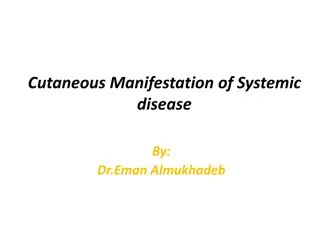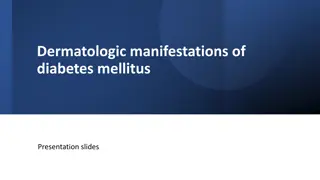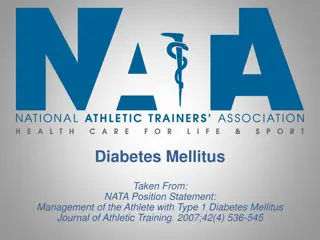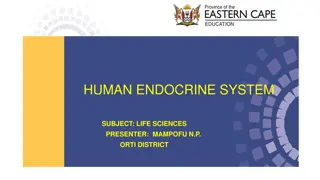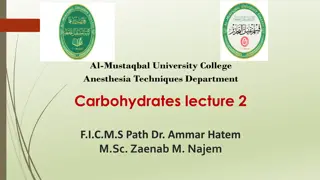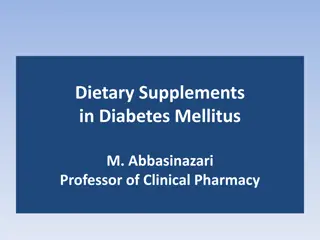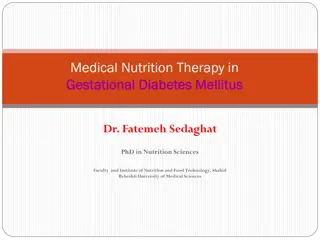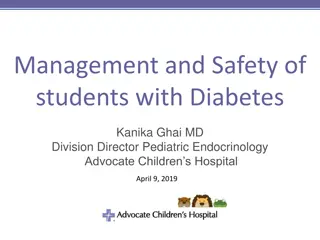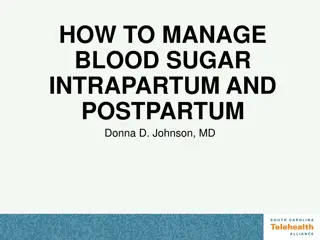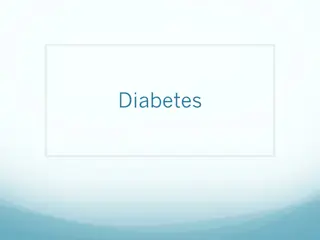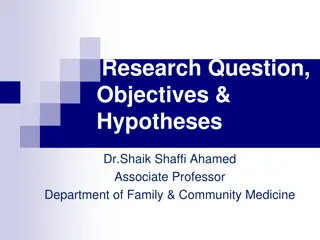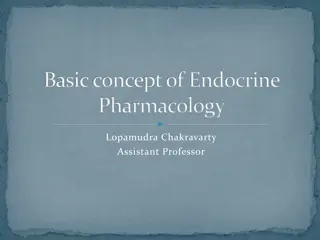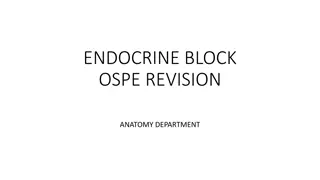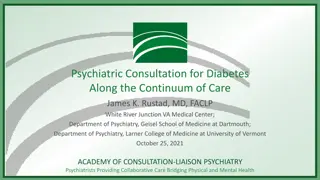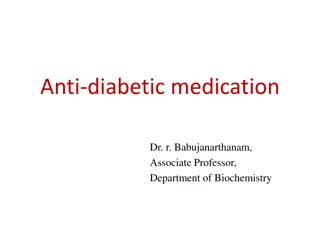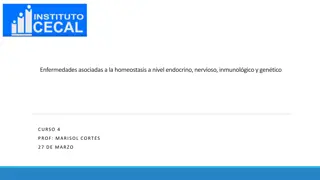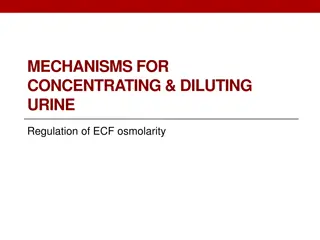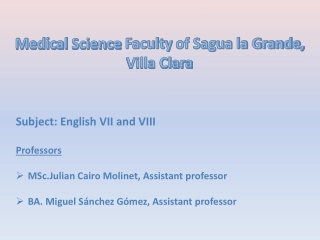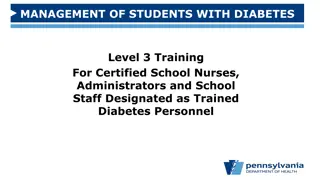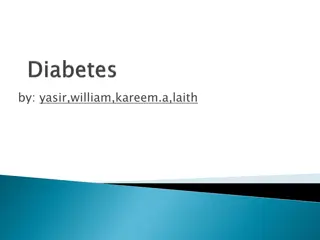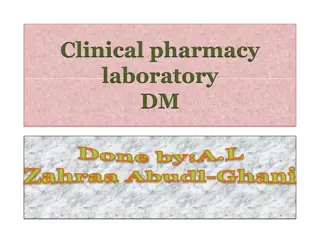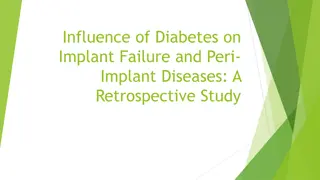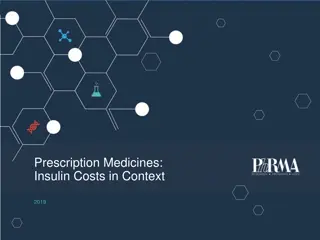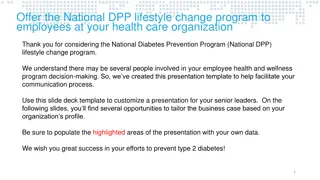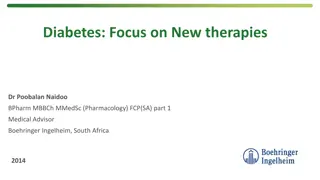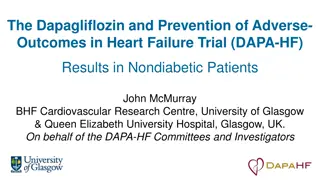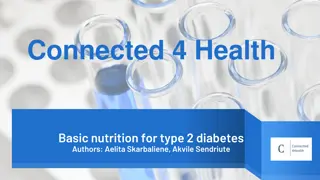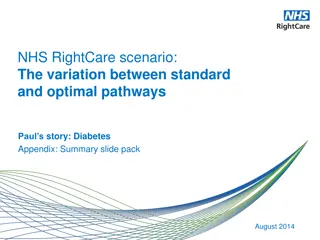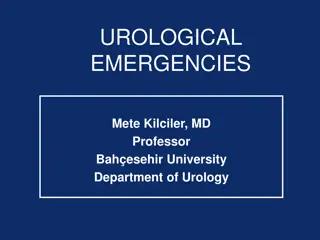Understanding Endocrine Emergencies and Diabetes Mellitus
The endocrine system plays a crucial role in regulating various bodily functions through hormone release. This presentation by Mrs. Bincy Cherian delves into endocrine emergencies, specifically focusing on Diabetes Mellitus. It explains the differences between Type I and Type II diabetes, their clinical presentations, complications, and prehospital management techniques for diabetic emergencies.
Download Presentation

Please find below an Image/Link to download the presentation.
The content on the website is provided AS IS for your information and personal use only. It may not be sold, licensed, or shared on other websites without obtaining consent from the author. Download presentation by click this link. If you encounter any issues during the download, it is possible that the publisher has removed the file from their server.
E N D
Presentation Transcript
Endocrine Emergencies PRESENTED BY MRS. BINCY CHERIAN ASST. PROFESSOR COLLEGE OF NURSING KISHTWAR
Introduction: Endocrine System Endocrine System controls Many body Functions, by Releasing Hormones Hormones Chemicals that Affect Endocrine Glands or Body Systems as well as ability to think with any clarity at all. Endocrine Release hormones directly into the blood which transport hormones to target tissue Exocrine Transport hormones to target tissue via ducts
Endocrine Emergencies: Diabetes Mellitus Diabetes Mellitus Carbohydrate utilization is reduced while that of lipid and protein is enhanced. Caused by insulin deficiency. Type I: Insulin Dependent Diabetes Mellitus (IDDM) Results from destruction of the insulin producing cells of the pancreas. Evidence also suggests an increase in glucagon production by the cells Peak onset in ages 11 and 13 (often referred to as Juvenile onset diabetes). New onset over 30 very rare Etiology differs; may be viral, environmental, and/or genetic. New cases usually occur in the fall and spring Symptom onset abrupt Prone to Ketoacidosis
Endocrine Emergencies: Diabetes Mellitus Type I: IDDM Clinical Presentation Polydipsia - BGL = intracellular dehydration and hypothalamus thirst response Polyuria - BGL = Glycosuria and osmotic diuresis Polyphagia - cellular carbohydrate, fat, and protein = cellular starvation Weight loss Due to loss of body fluid and tissue Fatigue Poor use of food products
Endocrine Emergencies: Diabetes Mellitus Type II: Non-Insulin Dependent Diabetes Mellitus (NIDDM) May have normal insulin levels and/or cells. Characterized by poor utilization of insulin Generally occurs over 40 years of age. Accounts for most cases. If you re of Pima Indian descent, sucks to be you Patient is usually obese, suffering end-organ complications 3 times more prevalent in adults w/ lower socioeconomic/education status Increased incidence in women with higher parity End-Organ Complications of Diabetes Accelerated atherosclerosis with medial calcification Microvascular disease; abnormal functio of capillary basement membrane Diabetic neuropathy; Autonomic dysfunction; Demyelination Abnormalities of Schwann s cells
Endocrine Emergencies: Diabetes Mellitus Prehospital Management of Diabetic Emergencies 1. ABC s/O2 Ascertain history from patient and/or family/bystanders 2. 3. Determine BGL (Normal range 60-120 mg/Dl) 4. Oral Glucose if BGL <60 and patient conscious. 5. If unable to take orally, est. IV and administer 25 g D50/W Child 0.5 g/kg 6. If unable to est. IV or orals, Glucagon 1 mg SC/IM 7. Repeat glucoscan after glucose administration Transport all patients on oral anti-hypoglycemic agents who develop hypoglycemia In general, give IV D50/W for any hypoglycemia <50 even if oral glucose given
Endocrine Emergencies: Hypoglycemia Hypoglycemia Defined Fall in blood glucose concentrations that elicits symptoms of glucose deprivation in the central nervous system. Sudden (Adrenergic sx) Gradual Diaphoresis, pallor Fatigue Tremulousness Confusion Tachycardia, palpitations Headach Visual distubances Memory loss Mental confusion, weakness, Seizures, coma
Endocrine Emergencies: Hypoglycemia Glucose Homeostasis Glucoregulatory organs include liver, pancreas, adrenals, pituitary and the hormones they produce Insulin (fed state) - Promotes uptake of glucose by the liver - Prevents use of other forms of energy (glycogenolysis, gluconeogenesis) - Fasting Hepatic glycogenolysis (good for 24-48 hrs) Prolonged fasting results in alternative energy source (lipoolysis, proteolysis) Gluconeogenesis is source of glucose for brain metabolism Hypoglycemia can result from disease of the glucoregulatory organs or from a breakdown of normal glucose homeostasis
Endocrine Emergencies: Hypoglycemia Pathophysiology Spontaneous Hypoglycemia -Alimentary (gut defect, GI surgery, etc.) -Early diabetes (new onset Type II) -Idiopathic hypoglycemia -Fasting -Islet-cell tumor -Extrapancreatic neoplasms -Endocrine related -Hepatic disease Induced Hypoglycemia -Insulin induced -Factitious -Sulfonylureas (oral hypoglycemic agents) -Alcohol -Misc. drugs (ASA, etc.)
Endocrine Emergencies: Ketoacidosis Diabetic Ketoacidosis Defined Characterized by hyperglycemia and ketonemia. Occurs as a result of insulin deficiency and stress hormone excess resulting in hyperglycemic, acidotic, dehydrated patient with profound electrolyte disturbances.
Endocrine Emergencies: Ketoacidosis Clinical Manifestations Polyuria, dehydration Sodium, Phosphorous, Magnesium deficits May have profound hypokalemia Signs and symptoms Treatment - Kussmaul respirations - ABC s, intubation for the comatose patient - Postural dizzyness -Fluid resuscitation (BSS) - CNS depression - Ketonuria - Anorexia - Nausea - Abdonminal pain - Thirst, polyuria
Endocrine Emergencies Nonketotoc Hyperosmolar Coma Severe hyperglycemia, hyperosmolality, and dehydration without ketoacidosis. Prehospital management is the same as for DKA. Gestational Diabetes Glucose intolerance that first occurs during preganancy. Usually occurs during the third trimester, obese women at greatest risk.
Endocrine Emergencies: Hyperthyroidism DEFINITIONS Thyrotoxicosis (Hyperthyroidism) Thyroid hormones exert greater than normal response Thyroid Storm Rare complication of hyperthyroidism where manifestations of thyrotoxicosis become life threatening. Also may be termed Thyrotoxic Crisis. Apathetic Thyrotoxicosis Rare form usually occurring in the elderly. Condition is often misdiagnosed as sx are few and subtle. Often presents as single organ failure (CHF). Patient may develop thyroid storm without the typical manifestations. Graves Disease Most common cause of thyrotoxicosis, autoimmune disorder characterized by hyperthyroidism, enlarged thryoid (goiter), opthalmopathy and dermopathy
Endocrine Emergencies: Hyperthyroidism Thyroid Storm Precipitating Factors Clinical Presentation -Pulmonary infection Diagnosis is difficult! General clues include: -Diabetics; Ketoacidosis, hyperosmolar coma, insulin-induced hypoglycemia -Hx of Thyrotoxicosis -Graves disease (or it s telltale eye signs) -Withdrawal of antithyroid drugs -Thyroid hormone overdose -Palpable goiter -Manipulation of the thyroid gland -Widened pulse pressure -Radioactive iodide Signs and Symptoms: -Vascular accidents (PE, etc.) -Fever, Tachycardia, Diaphoresis, Increased CNS activity and emotional lability. -Toxemia of pregnancy -If untreated will progress to a hyperkinetic toxic state, CHF, refractory pulmonary edema, shock, coma, and death -Trauma -Emotional Stress
Endocrine Emergencies: Hyperthyroidism Thyroid Storm Clinical Presentation (cont.) CNS disturbances may include: -Anxiety, restlessness, agitation, psychosis, confusion, obtundation, coma. -Thyrotoxic myopathy Cardiovascular abnormalities include -tachycardia, a fib -CHF GI symptoms -Pre-event severe weight loss -Hyperdefecation, diarrhea -Anorexia, N/V
Endocrine Emergencies: Hyperthyroidism Thyroid Storm Treatment Generally supportive -ABC s, intubation for comatose patient - IV fluids - Antipyretics prn - Treat congestive failure/pulmonary edema per protocol In-hospital therapies - IV glucocorticoids - Antithyroid preparations (PTU, Methimazole) -Retardation of TH release (iodide) - blockade
Endocrine Emergencies: Hypothyroidism DEFINITIONS Hypothyroidism Chronic systemic disorder characterized by progressive slowing of all bodily functions because of thyroid hormone deficiency. Primary Intrinsic failure of the thyroid gland Secondary Disease of the hypothalamus and/or pituitary gland Myxedema Refers to severe hypothyroidism. Nonpitting, dry, waxy swelling of the skin and SC tissue Myxedema Coma Rare complication of hypothyroidism. Usually occurs in elderly women, during the winter as a result of stress.
Endocrine Emergencies: Hypothyroidism Myxedema Coma Precipitating Factors Clinical Presentation -Pulmonary infection Diagnosis not difficult w/ history of previous physical presentation: -Hypoglycemia -Hx of thyroidectomy -Exposure to cold environment -Thyroid hormone replacement therapy -Hemorrhage -Iodine therapy -Hypoxia Diagnosis is difficult w/o the above information! -CVA -Hypercapnia, Hyponatremia -Trauma - Failure to take thyroid replacement meds -Amiodarone, blocker, phenothiazine administration
Endocrine Emergencies: Hypothyroidism Clinical Presentation (cont.) Treatment ABC s, intubation prn Hypothermia Initial hyperventilation Respiratory failure Gradual Rewarming Hyponatremia Correction of hypoglycemia Hypoglycemia Hypotension generally treated with pressors Cardiovascular changes -Hypotension -Cardomegaly -Bradycardia Nervous system -Coma -Seizures
Endocrine Emergencies: Adrenal Insufficiency DEFINITIONS Adrenal Insufficiency Decreased levels or absent hormones produced by the adrenal glands. May be a chronic disorder or acute life-threatening emergency. Primary (Addisons Disease) Intrinsic failure of the adrenal gland resulting in inablility to produce cortisol and/or aldosterone Secondary Disease of the hypothalamus and/or pituitary gland. Also can be due to prolonged steroid use Acute Adrenal Insufficiency Acute emergency
Endocrine Emergencies: Adrenal Insufficiency Tintinalli; Emergency Medicine; a comprehensive study guide
Endocrine Emergencies: Adrenal Insufficiency Acute Adrenal Insufficiency Precipitating Factors Clinical Presentation Chronic adrenal insufficiency and: Due primarily to cortisol insufficiency -New illness/stress -Profoundly weak and confused -Hypotension (significantly CO) -Hypermetabolic states -Pregnancy -Hyperpyrexia -Abrupt steroid withdrawal -Anorexia, N/V, Abdominal pain -Trauma, burns, surgery -Delirium, seizures Adrenal hemorrhage due to septicemia, etc. -Severe hypoglycemia -May be hyperkalemic
Endocrine Emergencies: Adrenal Insufficiency Treatment ABC s, intubation prn Fluid resuscitation Administration of glucocorticoid Correction of hypoglycemia


